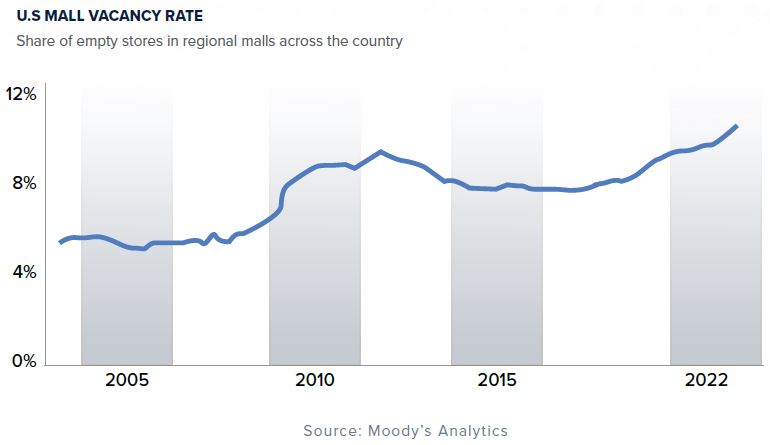From Malls to Medicine
The vacancy rate for regional malls in the U.S. hit a record 11.4 percent in the first quarter of 2021 up from 10.5 percent in the fourth quarter of 2020, according to Moody’s Analytics. The 90-basis point increase marked the highest the firm has ever seen, surpassing the record 80 basis point spike in the first quarter of 2009, which was at the height of economic hardship.

Malls are becoming a thing of the past as consumer behavior shifts from brick-and-mortar stores to online shopping and as mall owners struggle, investors are searching for opportunities in reusing these vacant retail spaces. At least 32 enclosed shopping centers across the country have been partially or fully converted into medical centers, including Vanderbilt Health’s renovation of the 1.1 million-square-foot Hickory Hollow Mall in Nashville, Tennessee.
“The possibilities for service offerings in a facility of this scale are endless,” said Dr. Jeff Balser, CEO of Vanderbilt University Medical Center.
Having both primary and specialty care options create an “all under one roof” experience for patients. The health system also has several offsite clinics that work with the medical mall and can offer telehealth options and free shuttle rides. This can effectively reduce variable costs and can help lower hospitals’ fixed costs by reducing dependency on “inflexible infrastructure.”
The Benefits of Shifting Medicine to Malls
Amid recent mall closures, several trends are emerging among abandoned retail spaces. The lockdowns brought by COVID-19 ensued closures of old, outdated shopping centers, forcing small business owners to relocate or close altogether due to rent increases and retail stores shuttering at an unprecedented rate. Though the pandemic dealt a blow to brick-and-mortar stores, it played a major role in accelerating overall e-commerce growth. There are new opportunities for adaptive reuse that provide benefits for both retail tenants and health care services.
Adaptive Reuse
Not only can repurposing parts of malls into healthcare hubs help existing retail tenants; it can bring healthcare services into the community in a meaningful way. The outbreak also reflected how integrated supply chains became an essential tool in building resilience within the market. Having store-level inventory present on vendor and retailer websites created just-in-time production capabilities that were integral for system resiliency, plus, it reduced costly shutdowns that could lead to lost revenues or brand abandonment.
Newer Technologies
The increasing growth of telemedicine created a higher demand for better access to healthcare services. The industry has seen an increase in growth through innovation and investments, as well as new opportunities from technology and consumer industries. Continuous development of advanced technologies, rising patient demand, and regulatory reforms are primary factors driving the market growth.
The U.S. virtual care market size was valued at USD 4.2 billion in 2021 and is expected to expand at a compound annual growth rate (CAGR) of 30.75% from 2022 to 2030.

Easier Access to Convenient Care
On the lease side, retail investors and owners are pursuing users in the healthcare industry and are signing leases in facilities as part of the trend from in-patient care to out-patient care.
According to the 2019 Healthcare Consumer Trends Report by NRC Health, a survey says that 51 percent of patients say that convenient access to care is the most important factor in deciding where they receive health care services from.
The continued push toward outpatient procedures will make malls increasingly attractive locations for healthcare. With ample space for parking and distributed locations, medical malls can provide preventive and primary medical care services to people who would otherwise not have access to them.
Savings Costs
Retail-centric healthcare is great because the care is coming to the consumer, which is reducing cost and freeing up more time for physician care instead of shuttling patients back and forth between doctor visits and residential or outpatient stays. Providing efficient healthcare services closer to patients where they need them most is key.
Medical malls can be the solution, acting as an extension of a local or regional hospital-based health system, serving its community while re-energizing the business model of the locating health system which lowers consumer costs. The transformation of malls is accommodating the rising number of people who now live in bigger cities where hospitals are becoming less of a centralized resource for them.









